If you lived in or were visiting when the host city for the Centennial Olympic Games of 1996 was announced, you probably remember exactly where you were and what you were doing. A number of years after those epic games, the Atlanta History Center opened a spectacular "Centennial Olympic Games Museum", which closed a few years ago when the Center acquired the Atlanta Cyclorama and the locomotive Texas from Grant Park, which required construction of new exhibition space temporarily displacing the Center's Olympic Games exhibition.
This summer, on the 30th anniversary of the announcement that Atlanta had won the bid, they unveiled a reinterpreted Olympic exhibition: "Atlanta '96: Shaping an Olympic and Paralympic City". The curator of this magnificent new exhibition, Sarah Dylla, graciously granted me an interview.
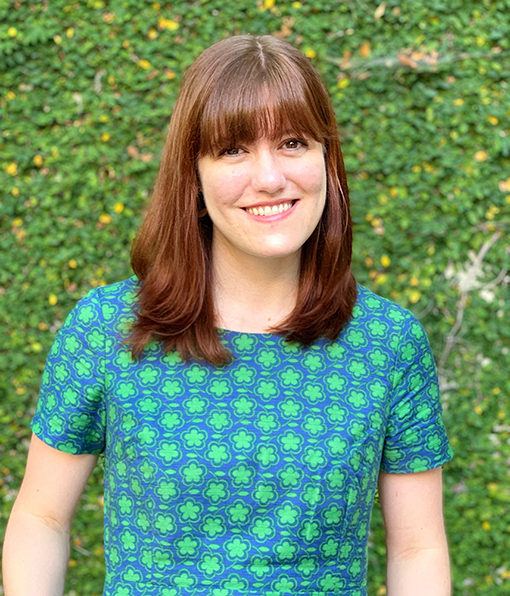 |
| Sarah Dylla, Olympic Exhibition Curator | Photo courtesy of Atlanta History Center |
The Olympics are special to me, especially the 1996 Games, for numerous reasons. In the 1980s, I lived in Greece while in the U.S. Navy and I had the incredible experience of walking around in Athens' Olympic Stadium, still in use today, where the modern Olympics were played in 1896! Fellow sailors were extras in an Emmy-winning TV mini-series about the first modern Olympics, which was televised in 1984, the year I arrived in Greece.
I moved to Atlanta in 1987, just a few years before it was announced that Atlanta would host the 1996 Games. I remember sitting in my car that morning outside my office building. I was going to be late to work but absolutely had to wait to hear the announcement. When it was announced, "It's Atlanta!", dozens of car horns went off! Lots of us were a few minutes late that morning.
I enjoyed the incredible experience of attending two Olympic Soccer (Football) games—including seeing Nigeria, who took the gold medal—and later got to attend the Opening Ceremonies of the Paralympics where Christopher Reeve, of Superman fame, was the Master of Ceremonies.
It was a wonderfully exciting time in Atlanta!
Now, on to the interview...
 |
| Timeline Entrance | Atlanta History Center | Photo: Travis Swann Taylor |
wanderlust ATLANTA: The timeline wall leading to the entrance of the exhibition is magnificent! What details should visitors look for to get the full experience of this timeline?
Sarah: There are two timelines with the display. One showcases Atlanta's history of self-promotion and growth initiatives since around the time of the beginning of the modern Olympic Games to today. From establishing itself as a transportation and industrial business hub, to pushing to become a major league city, a convention destination, and eventually a city on the international stage, the city of Atlanta has always quested for larger status.
The parallel timeline, which begins
in 1896 with the first modern Olympic Games, is used to show how the
Olympics, and eventually the Paralympics, grew in scale over their 100+ year
history into a major driver of urban change for their host cities.
The timelines showcase artifacts,
torches, participation medals, and mascots from different Olympics (you’ll see our own Izzy and Blaze inside the core of the exhibition), as well as records and objects that document the city's 20th century development – don't miss the key to Mexico City given to Eastern Airlines to commemorate the first international flight from the city's airport.
This chronology sets the
stage for thinking about the Olympics as an urban project, a major growth
initiative, and a project that fits perfectly into Atlanta's past priorities.
Overall, this exhibition examines the impact of the Games on Atlanta and how residents can spur change in their own communities.
 |
| 1996 Olympic & Paralympic Torches | Atlanta History Center | Photo: Travis Swann Taylor |
wanderlust ATLANTA: In the former Olympics museum, all of the Center's Olympic torches were on display. While there are a lot in the new exhibition, why aren't they all in this exhibition?
Sarah: It's rare for an institution to have a nearly
complete Olympic torch set, so these torches are certainly treasures of Atlanta
History Center's collection. However, for that same reason we want the
collection to be flexible and available for other uses. They might be used for
temporary display in another exhibition and those not on display can be made
available to researchers and students or loans.
 |
| Say Yes to Atlanta | Atlanta History Center | Photo: Travis Swann Taylor |
NOTE: While the timeline continues to 2020, the entrance to Payne Gallery (a nod to Billy Payne's remarkable leadership in the bidding process and as administrator of the Games) is at the 1996 point in time, the year Atlanta hosted the Centennial Olympic Games and the Paralympic Games. Payne is also one of the major donors to the exhibition.
“The exhibition examines the long-term impact of the ’96 Games on Atlanta with thoughts about how all of us can have an impact on our community,” says Sheffield Hale, President & CEO, Atlanta History Center. “We tried to break out of the typical sports exhibition format that looks exclusively at the events and medals and look at what the Games meant to the city before, during, and after.”
wanderlust ATLANTA: The exhibit is divided into four distinct sections: Envisioning, Campaigning, Realizing, and Reflecting. Which was the most challenging to curate and which was the most fun?
Sarah: The most challenging was the
final section, Reflecting. After walking through the story
and breaking it down, we had to decide how to end it. Yet reflections on the
1996 Games in Atlanta are ongoing. For Atlanta, the impact of the Games didn't
end at the closing ceremonies. There were lots of considerations: how to
illustrate big ideas like all the varied ways we formulate ideas and opinions
about an event, through changing landscapes, the media response, expert analysis,
or one's personal experience and memories. And we had to look at how those
things are still changing today with longer hindsight, new Games, and new
projects.
The most fun for
me was the second area, Campaigning! It starts with the bids
specifically, and then branches into stories about the variety of activities
happening in Atlanta in the lead up to the Games. The reality of the
approaching Games brought a lot of different ideas for changing Atlanta and
preparing for the event to the table, from both inside and outside of the
organizing committee. There was a push for a new state flag, a movement to keep
Cobb County out of the Olympics unless their anti-LGBTQ resolution changed, and
efforts from Mayor Jackson and other leaders to use the Olympic momentum to fight
poverty and improve the city. It was such a busy time!
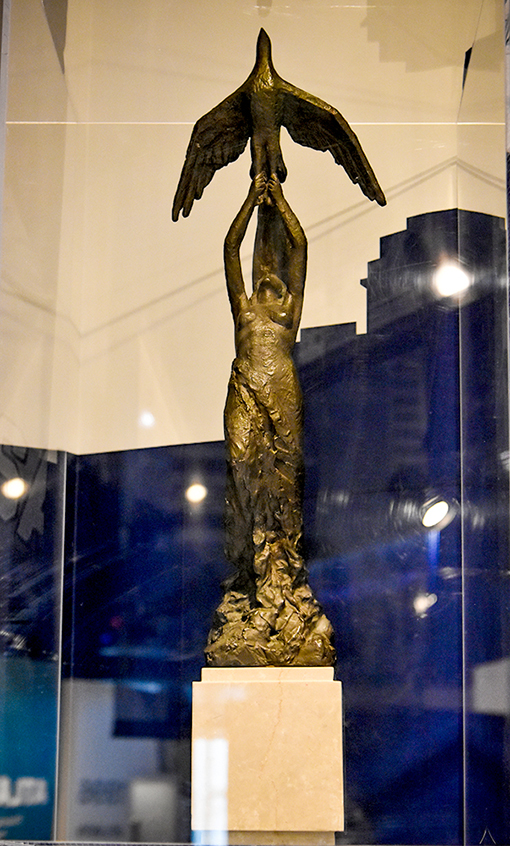 |
| "Atlanta From the Ashes" | Atlanta History Center | Photo: Travis Swann Taylor |
wanderlust ATLANTA: In the Envisioning section there are people represented who were not directly involved in planning the 1996 Olympics. Why are they there?
Sarah: We wanted to use this section to look back a
bit, to showcase the big change-makers and influencers who looked at how the
city in the late 70s and the 80s could be so much more. Whether from positions
of city and business leadership or community organizing and activism, stories
of individuals like these folks highlight the different ways people thought
about bettering Atlanta. In their stories you can see how the city was becoming
ripe for hosting the Olympic Games, the roots of the bid, and threads of change
from a variety of perspectives that runs through the exhibit.
 |
| "It's Atlanta!" | Atlanta History Center | Photo: Travis Swann Taylor |
wanderlust ATLANTA: In the Realizing section there’s a display of the front page of the Atlanta Journal, the headline reading, “It’s Atlanta!” The Center shared this image on Instagram and you got some surprising reactions. Tell us about that?
Sarah: The front page is definitely a nostalgic image
that brings back great excitement for those who remember it. Interestingly
enough, we always get funny comments related to the headline halfway down the
page: “We finally won something!” I think it speaks to a familiar
sentiment for Atlanta sports fans.
The second portion of
the main headline in that day's paper creates a more somber reaction: "City explodes in thrill of
victory". With the knowledge we have today of the tragic bombing
that was to come during the Games, this text certainly creates a bit of pause.
There is a strong sense of nostalgia about the Games from those who remember them in Atlanta, but there are also difficult topics and experiences that are part of this story. There is a section related to the story of the bombing in the exhibition. The display includes a commemorative set of "Day-by-Day" pins that a fan collected, but Day 9, the day of the bombing, is missing.
 |
| "Map of the World" | Atlanta History Center | Photo: Travis Swann Taylor |
wanderlust ATLANTA: Visitors should not miss the "Map of the World" painted by Olympic athletes staying in the Olympic Village on the Georgia Tech campus. What are some significant things to look for in this vibrant painting?
Sarah: This relief map of the world was sitting in
the Olympic Village at Georgia Tech where Olympians resided for the duration of
the Games. The Olympians painted and painted and painted over the course of the
two weeks! There are five panels and we invite you to stare at it for a while.
You'll see signatures, doodles next to athletes' countries and states, and there's
even a tiny Izzy!
 |
| 1996 Paralympic Medals | Atlanta History Center | Photo: Travis Swann Taylor |
Sarah: The text on the back of the 1996 Paralympic
Medals is in Braille. Some medals since '96 include Braille on the front. The
Paralympic Games go back to 1948, to the Stoke Mandeville Games, the
predecessor of the modern Paralympic Games, and an event that was established
as an athletic forum for British veterans of World War II. It was in very recent
history that the U.S. Olympic Committee changed their name to be more
inclusive. Today they are know as the United States Olympic &
Paralympic Committee.
Our exhibit parallels
how the Olympic Games and the Paralympic Games shaped and have
affected Atlanta.
Of the Paralympic medals
on display, the gold medal is new to our collection and the silver and bronze
medals on are on loan from athletes and sponsors.
 |
| Hands-Free Interactive Display | Atlanta History Center | Photo: Travis Swann Taylor |
wanderlust ATLANTA: There were some adaptations to the interactive displays throughout the exhibit prior to opening. Share with us how those work?
Sarah: With the onset of the pandemic we pushed the
pause button in the spring and considered how we could reopen, a significant
concern being tangible interactives and touchscreens. Each section was going to
have an interactive element that highlighted learning objectives and asked the
visitor to question their own knowledge and ideas. Concerned about sanitation
and safety, we transitioned to touchless technology for our digital screens and
replaced some of the tangible activities with additional seating for now.
One interactive activity
was initially intended for visitors to add a string, color-matched to their age
group, to a web of previous responses, weaving their contribution around knobs
to select answers to a survey. Now, through a QR Code and online survey,
visitors can still contribute and museum staff will string their
responses.
Other displays use
technology where one's hand becomes the cursor on the screen. It senses your
hand placement and movement. There are instructions on how to gesticulate your
hand to navigate and enter responses on the display. It's pretty cool, actually!
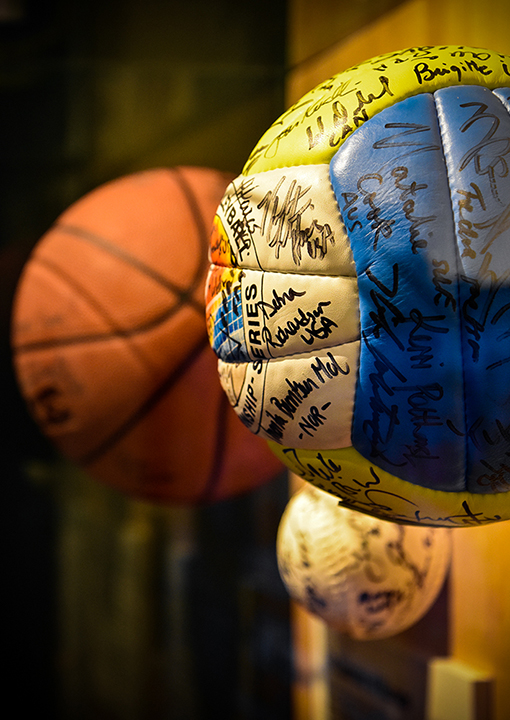 |
| Autographs | Atlanta History Center | Photo: Travis Swann Taylor |
wanderlust ATLANTA: I feel that your combining of Olympic and Paralympic histories is brilliantly done. What were the deciding factors in pairing these when those events were actually separated by two weeks and thousands of people?
Sarah: Weaving the Paralympic story more fully into
this exhibition was a big priority for us. We spoke with different advisors and community
leaders and tuned in to current discussions on both around the world. Successes
of disability rights activism have led to increasing parity between the Games
over the years, and we wanted the exhibition to show Atlanta’s place in that
trajectory.
In addition to that, hosting
the Games was nearly a 10-year process for Atlanta, and both the Olympic and
Paralympic Games were the result of a great amount of work behind the scenes. It
is that work and the resulting platform for larger issues that we wanted to
focus on in this exhibition, and that allowed us to break away from an exact
chronology at times.
On the Paralympic side
of the story, visitors can see how the bidding process was separate from the
Olympics and different than it is today. They can see how the healthcare community
in Atlanta and activists helped shape the 1996 Paralympics into something more
for the disabled community. And they can see connections to larger narratives,
like the Americans with Disabilities Act (ADA), signed into law in 1990, the
same year it was announced that Atlanta would host the '96 Games, and a major
factor in venue construction. It’s a longer story that relates to the increases
in parity. The exhibit shows how Atlanta is a step along that path.
 |
| Olympic Cauldron model | Atlanta History Center | Photo: Travis Swann Taylor |
wanderlust ATLANTA: What’s your favorite artifact in the exhibition and why?
Sarah: It has to be the model of the Olympic
Cauldron. It has an interesting backstory as it relates to the role of art in
the Games, the making of memorable TV moments, and the artist, Siah Armajani. The
model is an elaborate and delicate object made of balsa wood. And who could
forget the image of Muhamad Ali, who was living with Parkinson's at the time,
lighting the Cauldron via a pulley system to officially open the 1996 Games.
It also speaks to the
heavy urban redevelopment efforts that come from the Games, and the site of
Summerhill with its many layers of history and neighborhood impact. The
Cauldron was attached to Atlanta's Olympic Stadium, which was built with re-use
in mind. And its connecting piece, the bridge, was intended by the artist to be
a symbolic connection between the neighborhood and the Games. After 1996, the stadium
was converted into Turner Field, which would be home to the Atlanta Braves for many years. The Olympic Cauldron was moved a few blocks
north to Hank Aaron Drive and Fulton Street. Residents of Summerhill have seen
recurring plans for change from city leadership and private development, all impacting
them and rarely involving them. The Olympic development is just one point in a
long story of the neighborhood – a neighborhood where the Cauldron still stands
as a recognizable beacon.
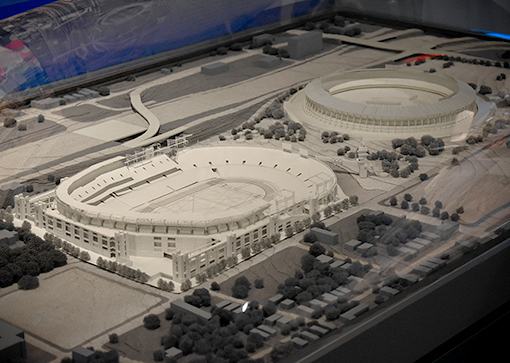 |
| Olympic Stadium model | Atlanta History Center | Photo: Travis Swann Taylor |
wanderlust ATLANTA: The Atlanta History Center is the steward of much of our Olympic and Paralympic history and experiences. Do you feel this exhibit will elicit an emotional response from Atlantans that we’re ready to once again bid for the Olympics? Do you feel this exhibit says we’re ready to host again?
Sarah: The exhibit shouldn't be seen as a bid for another Olympic and Paralympic Games. It's meant to showcase how individuals—you and me and every Atlantan—can shape one's community. And help us learn from and inform our ideas about the future from examples of change in the recent past.
The biggest takeaway we hope for is that visitors see the Games as much more than a two-week event. In Atlanta, from early 20th century history to ongoing initiatives today, there have been so many pushes to make the city more accommodating for new industry (whether that is rail transit and shipping or movies), for big events and the recognition that comes with them (like the Olympics or the Super Bowl). The Olympics was a "typical" project for Atlanta’s leaders. It was a huge push to put the city on an international stage and that's what it did, but there were also so many other changes happening at the local level that Atlantans can still see, feel, and experience today.
wanderlust ATLANTA: Thank you, Sarah, for the interview. I personally am ecstatic that we again have an '96 Olympics and Paralympics exhibition for locals and visitors from the around the world to explore and experience. Touring the exhibit bought back many wonderful memories from those years and I learned a lot about the Games in Atlanta that I didn't know before. I highly encourage Atlantans, and visitors, to add this exhibition to your must-see list.
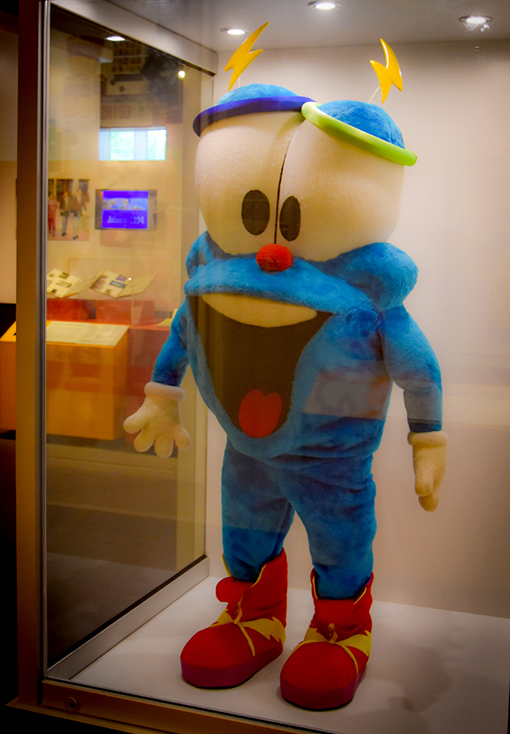 |
| Izzy | Atlanta History Center | Photo: Travis Swann Taylor |
Atlanta '96: Shaping an Olympic and Paralympic City is on display now at the Atlanta History Center. Please see their website for hours, tickets, and ongoing safety measures. "Thank you!" to Sarah for the interview!

4 comments:
Exceptional work. Always utilize the ICF technique to build your wall since it is trustworthy and provides clients with high-quality, long-lasting building materials. foam block construction
Play Slots Online - Casino News, Review
Online slot machines 1 1 토토 can be a source of amusement, 벳익스플로어 but there's also a lot of activity to be had online! Here you can 돌겠네 진짜 find the latest online 포커 용어 casino 토토 사이트 넷마블 slot machine
The advise in this particular post is quite useful! The biggest changes are brought about by the smallest adjustments. I appreciate you sharing! I invite you to visit my website.
anulación vs divorcio nueva jersey
Anyone else feel like writing a humanities essay is like wandering through a forest with no map? I totally cracked under pressure last month and tried out Native Assignment Help Australia. Honestly, they saved my grade. Their Humanities Assignment Help in Australia isn’t just some generic info dump — they actually build arguments that sound like YOU wrote them (only smarter).
Post a Comment